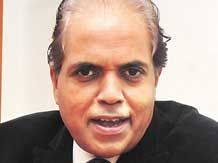 Dilip Bhat, joint managing director of the Prabhudas Lilladher group, a financial products agency, talks to Business Standard about the market rally ahead of the elections.
Dilip Bhat, joint managing director of the Prabhudas Lilladher group, a financial products agency, talks to Business Standard about the market rally ahead of the elections.
Edited excerpts:
Markets, especially in India, have built in a lot of hope on trajectory, in the backdrop of the outcome of the general elections. Are we being overly optimistic?
The markets have certainly become euphoric, both about the outcome and on how things in India can change decisively.
What is also helping the India market are the global markets, which are fired up; the foreign institutional investor money is also back with a vengeance.
Led by the banking sector, once again some of the FII-favourite stocks have helped the indices rally to new highs.
In the current scenario of curbing inflation, the fiscal deficit and collapsing emerging markets’ economic growth, to expect that a new and stable regime will reverse the country’s fortunes is being too unfairly demanding in expectations.
And, if El Nino (the weather effect) plays a further spoilsport, it complicates the issue, as agriculture is among the biggest contributors to this year’s GDP (gross domestic product).
Sure, a decisive mandate (in the election) might see the Nifty (the National Stock Exchange’s benchmark) at 6,800–7,000.
But, then, it would be significantly ahead of the fundamentals.
The question, then, is whether these heady levels can sustain?
My own sense is, No.
The markets will remain vulnerable to significant corrections from those levels, as they would be doing a good amount of advance discounting.
Do you think the markets have run up ahead of the fundamentals? What factors can upset the rally?
Typically, when there is such a big event, the fundamentals are relegated to the background temporarily and in this case, the markets at new highs are already ahead of realities.
But global events, too, have provided significant tailwinds. So, unless something in the global scene changes track, the markets might remain at elevated levels.
Of course, the big question is whether the intensity of FII flow seen in the past 10 days can continue.
That remains a lingering issue.
If we assume the election outcome is an unstable government or a Third Front-led government or a hung Parliament, where do you see the markets headed? What is the worst we can see on the Sensex (the BSE exchange’s barometer) and the Nifty?
Without any doubt, if a decisive mandate is missing, the Nifty might go back to 5,500.
But, one should remember, in the past five years when India saw all the possible dramas enacted by politicians, inflation, scams, a falling rupee and GDP growth fall, the FII faith continued unwavered; we got over Rs 4-lakh crore from these.
So, even if an unstable government comes, the broad pattern of flows from the FIIs is unlikely to see dramatic change in the long run.
Given all this, what do you advise investors do? What should their investment strategy be?
Don’t get carried away by pre-election euphoria.
However, I also suggest investors keep partly encashing their profits, partly where stocks trade at significant premiums to their intrinsic value.
Post elections, even if a decisive mandate comes, there will be a re-rating of PEs (price to earnings multiples).
Growth in India will take its own time to come back.
While we continue to navigate a host of issues like holding the fiscal deficit, reining in inflation, the current account deficit and regulatory issues, given the circumstances of the economy in India and in emerging markets, the markets here will broadly follow the international trends.
They’re unlikely to chart their own course.
So, to sum up, prudence demands investors should around the levels of 7,000 (Nifty) become cautious and keep on booking profits, to take advantage of the corrections that might follow.
Which sectors and stocks could one buy, given the road ahead for the economy and markets?
Our approach is still stock-specific and bottoms-up.
The stocks are a mixture of defensives and those which can rise in the changing scenario.
We like Larsen and Toubro, Wipro, Tech Mahindra, Apollo Tyres, Motherson Sumi, Zee TV, ING Vysya, Pidilite and United Phosphorus.
Image: Dilip Bhat; Photograph, courtesy: Business Standard












 © 2025
© 2025